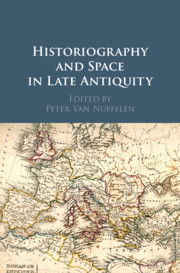Book contents
- Historiography and Space in Late Antiquity
- Historiography and Space in Late Antiquity
- Copyright page
- Contents
- Contributors
- Acknowledgements
- Introduction
- Chapter 1 Constantinople’s Belated Hegemony
- Chapter 2 Beside the Rim of the Ocean
- Chapter 3 Armenian Space in Late Antiquity
- Chapter 4 Narrative and Space in Christian Chronography
- Chapter 5 The Roman Empire in John of Ephesus’s Church History
- Chapter 6 Changing Geographies
- Chapter 7 Where Is Syriac Pilgrimage Literature in Late Antiquity?
- Bibliography
- Index
Chapter 5 - The Roman Empire in John of Ephesus’s Church History
Being Roman, Writing Syriac
Published online by Cambridge University Press: 12 August 2019
- Historiography and Space in Late Antiquity
- Historiography and Space in Late Antiquity
- Copyright page
- Contents
- Contributors
- Acknowledgements
- Introduction
- Chapter 1 Constantinople’s Belated Hegemony
- Chapter 2 Beside the Rim of the Ocean
- Chapter 3 Armenian Space in Late Antiquity
- Chapter 4 Narrative and Space in Christian Chronography
- Chapter 5 The Roman Empire in John of Ephesus’s Church History
- Chapter 6 Changing Geographies
- Chapter 7 Where Is Syriac Pilgrimage Literature in Late Antiquity?
- Bibliography
- Index
Summary
Although time is crucial for historiography, space is another important dimension of historical writing. The kind of space that is relevant to authors and becomes visible in their works depends on their respective contexts and approaches. As regards church historiography, one major issue is the relationship between ecclesiastical and political space, which ideally should coincide, but never does. This becomes even more palpable in works that stem from the periphery of the empire. One case in point is the ecclesiastical history of John of Ephesus.
- Type
- Chapter
- Information
- Historiography and Space in Late Antiquity , pp. 113 - 135Publisher: Cambridge University PressPrint publication year: 2019
- 1
- Cited by

